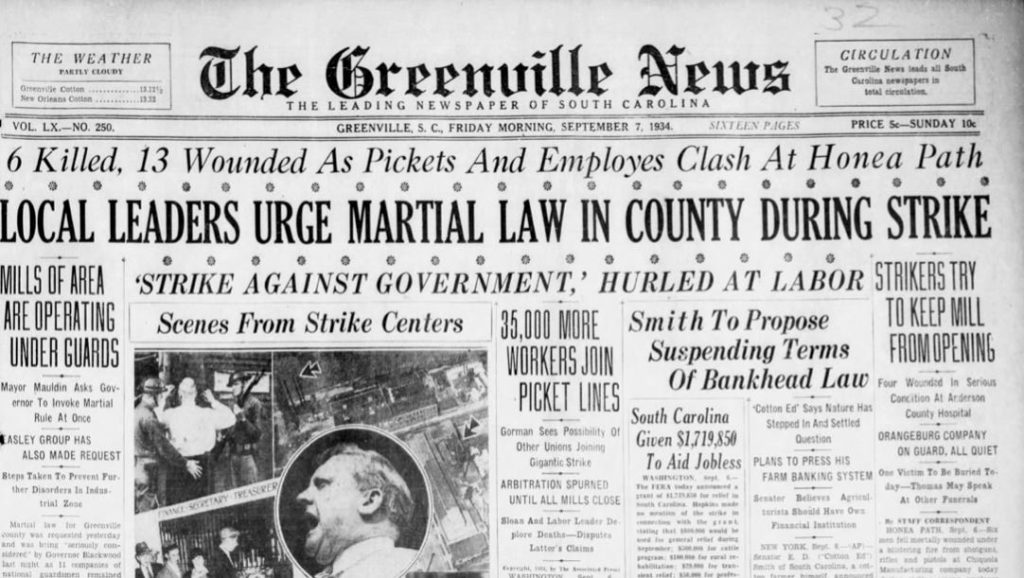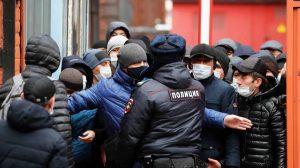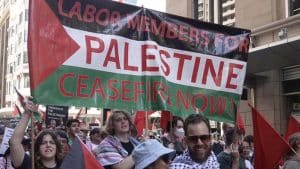With the fight of Amazon workers in Bessemer, Alabama to unionize their workplace, it is a good time to turn back to the history of labor organizing in the South. One important struggle to highlight is the 1934 textile workers strike. The story does not have a happy ending, but needs to be told for its place in the complicated historical context of unions in the South and to provide critical lessons for future class struggle in the region.
Suffering Textile Workers
We all know about the 1929 stock market crash that set off a worldwide epoch of hardship. By 1933, one in four workers in the United States was unemployed, and for those with jobs, hours were cut back significantly, their meager wages scarcely paying for life’s bare necessities. Higher-skilled workers were better off than their lower-skilled counterparts who labored primarily in farms and factories. These workers were displaced in large numbers, and people living in states whose economies depended on agriculture and industrial work suffered enormously.
Crisis is endemic to capitalism, and Southern farmers and textile workers perhaps felt this one coming. By the time the Great Depression hit, the South was years deep into an economic downturn that had lasted throughout the 1920s.
After World War I, the once-mighty cotton industry collapsed. The boll weevil infestation had been decimating cotton since the turn of the century, forcing farmers to plant more and more cotton to take advantage of the profitable crop while evading the pest. After the war, demand plummeted and farmers were left with more cotton than they could sell.
The plummeting value of cotton had an obvious impact on the textile industry. In the early years of the 20th century, the hub of the textile industry had moved from the Northeast to the South, providing low-wage jobs to many poor southerners. Textile factories often employed entire families, and relied heavily on the work of children under age 16. Black men performed some of the most difficult jobs at the factories, but Black women were almost entirely excluded from the Southern textile industry. Black and white workers were divided into separate factory rooms. (It wouldn’t be until the 1970s that Black women finally made inroads into the Southern textile industry.)
Prior to World War I, textile companies had rapidly increased production with new steam technology made possible by coalfields opening up throughout the South, allowing them to expand operations while cutting labor costs. Factory owners’ power grew; they controlled entire towns, creating slumlike living conditions for their repressed, exploited workers, who couldn’t even dream of collectively organizing their workplaces. When post-war demand plummeted and these mills could no longer sell their products at high prices, employers began to reduce workers’ hours and increase their workload without increasing their wages. They also began implementing Taylorist “scientific” efficiency techniques that regulated workers and squeezed out what little extra labor they could, like toothpaste from a tube.
This period of increasing “efficiency” and exploitation became known as the “stretch-out.” Attempts to fight back were brutally repressed. Resentment sizzled.
Textile Workers Unionize
By 1929, textile workers throughout the South became sick of their long hours and meager wages. The region’s climate for labor organizing was worse than up North — greater opposition to unions meant unionization rates hovered around half of the rest of the country. The National Union of Textile Workers (NUTW) had tried to organize the South in the late 18th century, but the financial power of textile mill employers effectively ran them out of town. The bosses began forcing workers to renounce unions in advance of being hired (called “yellow dog” contracts).
In 1933, newly elected president Franklin D. Roosevelt, fearing the combination of prolonged economic adversity and brewing anti-capitalist sentiment (potentially fatal to the capitalist status quo), knew that appeasing the working class was essential to avoid a revolutionary situation — and convinced the rest of the ruling class. He responded to the Depression by pushing through the National Industrial Recovery Act (NIRA), one of the first of a series of New Deal policies and programs spurred by radical labor activists but credited to FDR. The act suspended antitrust laws, encouraging alliances between industries to draft “codes of fair competition” aimed at protecting consumers, competitors, and employers. Title I, Section 7 guaranteed workers the right to join trade unions and banned the aforementioned yellow dog contracts, as well as established regulations surrounding maximum working hours, minimum wages, and working conditions. NIRA also established the National Recovery Administration and created the Cotton Textile Industrial Relations Board (CTIRB) to address complaints of employer code violations.
The new law set off a wave of unionizing throughout the country, especially among textile workers. Emboldened by the legislation, hundreds of thousands of textile workers poured into the United Textile Workers of America (UTW) to join the 40,000 already unionized.
Yet working conditions worsened. The new law had no teeth, and enforcement was essentially futile. Employers continued to stretch hours and cut wages, blacklisting employees who joined unions and evicting them from company housing. Though the bosses’ actions blatantly violated the new codes, they were often supported by government leaders and faced no real consequences from the CTIRB. The board issued reports that hardly mentioned stretch-out conditions and did not acknowledge the role of unions. It also neglected one of its key roles; in its first year, it investigated only 96 of 4,000 complaints received.
The UTW, headed by Thomas McMahon and Francis Gorman, threatened to strike, but backed down in exchange for two seats on the CTIRB and a government “study” of textile industry working conditions. As historian John A. Salmond notes, the union leadership was “woefully unprepared” for a national strike — most Southern textile workers had only just joined unions that summer.
Local union leaders were furious at the leadership’s backdown. They were even more determined to wield their newfound collective power and stand up to the bosses.
A Militant Strike Begins in Alabama
Angered by the UTW having called off the strike, an Alabama state strike convention was assembled, bringing together the leaders of the 42 Alabama textile locals. All but two voted for a strike that then began in Huntsville, a center of cotton production. By week’s end, all the city’s mills had closed, and the struggle then spread throughout other northern Alabama towns: Florence, Anniston, Gadsden, Cordova, Jasper, Guntersville, Albertville, and Birmingham.
The Gadsden UTW local was particularly militant. The Dwight Manufacturing Company cotton mill was one of the area’s biggest employers, along with Goodyear and Gulf Steel. Workers at Dwight underwent an enormous organizing campaign over the summer of 1934, and by July nearly 90 percent of its workforce was in the UTW. That effort was no small feat in a town like Gadsden, known throughout the region as pro-business, anti-union, and with factory owners working directly with local officials and civic leaders.
Engaging in labor organizing posed a serious threat to economic security and personal safety. One mill worker, Eula McGill, described the dangers of being a union organizer in Gadsden, Alabama:
Most of the people who were involved and carrying the brunt of it were the workers in the plant who were what we would call volunteer organizers, of which I was one. Those people were harassed in their homes by the people that were anti-union that worked with them, the police, because in Gadsden, Alabama a lot of people know the history of the struggles of the workers there to organize … So many people who were active in the organizing campaign, the workers who were in the plant and on the volunteer organizing committee and we called them volunteer organizers, were beaten up, taken out and flogged and it was very risky.
On July 12, Dwight workers shut down operations by walking out of the factory and setting up picket lines. They demanded a minimum wage of $12 for a 30-hour week, an end to the stretch-out, reinstatement of workers dismissed for union activity or even membership, and recognition of the UTW. McGill said she and many of her fellow workers felt “there was no place to go but up.”
The Alabama actions spurred a special UTW convention in mid-August, where the question of a national strike was discussed. McMahon and Gorman were hesitant and skeptical about the readiness of the union’s organizational and financial capacity to handle a national strike. However, the Southern delegates were decisive in swaying the union convention toward a strike vote.
The decision to strike was taken by the union delegates and leadership alone.. As American labor historian Philip Taft noted, “The strike was called without adequate preparations and without a vote of the hundreds of thousands of workers who were called to join in the walkout.” It is an important lesson for the working class today: the lack of a vote by the rank and file was a serious mistake for union leaders. Union struggles are strengthened by collective action that includes decision making. Leaders cannot be allowed to throw workers into the fire while they sit back, protected by their privileged positions, and hope for the best.
The leadership was well aware of the lack of preparations. McMahon hoped there would be presidential intervention so a strike could be averted. Employers and the general public believed there was not enough support among workers to constitute a genuine threat. Nevertheless, Gorman called the strike on August 30.
The New York Times predicted an enormous strike that would mobilize workers from Maine to Alabama. In an effort to gain widespread public support, Gorman disconnected the struggle from radicalism and emphasized the conservative nature of the UTW leadership, promising that the strikers would remain “orderly.”
In the absence of rank-and-file preparation for the strike, the union needed a strategy for mass worker mobilization. Especially in the South, many mill towns were isolated and their unions were new and highly decentralized. The UTW borrowed from the United Mine Workers the tactic of “flying squadrons” — groups of hundreds of workers in cars and trucks who would drive to remote towns and shut down the mills. It was a tactic that became particularly famous when it was later used by the Minneapolis Teamsters during their epic strike that same year. These flying squadrons closed at least 27 mills by Labor Day, and historians believe that they accounted for the success of the strike’s first week.
The mill owners, with their excess supply of textiles, did not act immediately. Still, they were infuriated by workers withholding their labor, and used their connections with the state to break the strike. Cops used violence all over the country; strikers from the Deep South to New England were teargassed, beaten, jailed, and in several cases, killed. Chiquola Mill in Honea Path, South Carolina, saw the most violence: six workers were killed and 20 were wounded. The strike was beginning to seem like a lost cause.
A Bitter Defeat
Many factors, both objective and subjective, contributed to the bitter defeat of the 1934 textile strike. By mid-September, using the flying squadrons as a pretext, 10,000 National Guardsmen were mobilized in Georgia, South Carolina, North Carolina, Alabama, and Mississippi, with an additional 1,500 armed deputies to support them. They were stationed at borders and outside of mills to “protect” private property and strikebreakers. This deployment escalated the confrontations and further decreased public support for the strikers. Governor Green of Rhode Island declared, “There is a Communist uprising and not a textile strike in Rhode Island.”
The surplus of textile supply harmed the strikers’ cause, diminishing the public’s perception that the workers were indispensible. On September 2, the CTIRB “study” was released, and it was yet another blow to the strikers. The report recommended leaving contract negotiations up to individual mills, did not require the rehiring of striking workers, and did not call for mill owners to recognize the UTW or any other union. Despite the hope and excitement generated by the NIRA, it ended up exemplify that labor reforms alone cannot be counted on to advance the interests of workers; ultimately, class struggle must be tied to a struggle to overthrow capitalism itself.
Two days after the report was released, and at Roosevelt’s insistence, Gorman was forced to declare a victory and asked the strikers to go back to work.
Workers knew the strike was far from a victory. Aside from marginal increases in their minimum wages, the workers were more or less where they were before the strike, but with a badly bruised reputation. Angered mill owners refused to rehire workers who had participated in the strike, continuing to blacklist them and evict them from company housing. Replacement workers were forced to sign yellow dog contracts. McGill recounted:
Of course, I didn’t last very long, I got discharged and after the general textile strike, which most of the people that came out on strike lost, we did form some good local unions, some of them are still in existence today in Alabama. Most of us, however, had to go back without a contract.
The strike had failed, and while both workers and union leaders paid the price, the rank and file took the deadliest blows.
The 1934 textile strike demonstrates the critical role unions play in class struggle, and also reveals just how important it is that they be run by the rank-and-file workers themselves — as all too often their leaderships are ready to accept small concessions or even outright defeat rather than continue to wage the fight. In this particular case, the strike was a catastrophe for textile unions across the country. The struggle represented the apex of textile worker organization for the next several decades in the South, until new organizing efforts emerged in the 1970s, and union membership deteriorated after its defeat. Workers were disillusioned by their faith in the government boards and resented the national union for declaring victory when they had so obviously lost.
While the passage of NIRA inspired many workers to join unions, they quickly realized that the union leaderships were not supporting their broadest demands, nor were they protecting them when the capitalist class mobilized its violent forces. Many workers felt bitterly betrayed by their “progressive” government and the unions they had joined.
Legislation crafted by bourgeois policymakers, however progressive, will always fall short. Reforms, while necessary, are never enough — as NIRA showed textile workers in 1934 — and they cannot be workers’ ultimate goals.
The textile unions were not prepared to take on the state apparatus that was mobilized at the first sign of threat to capitalist profits and authority. The unions had not sufficiently built an organization rooted in the working class that was capable of taking on the power of the bourgeoisie and standing firm.
While the 1934 strike demonstrated the quick class consciousness that can be built through experience in class struggle, it is also essential to engage in battles that the working class is capable of winning. From the newly populated unions which had yet to build solid networks to the lack of enforcement power of NIRA, the favor was in the hands of the employers at the time the strike was called.
In the meantime, workers must prepare, building bodies of self-defense to be able to stand up the heavily armed bodies of the state that are ready to strike when the working class threatens capitalist profits.
Legacy
Unions are the greatest organizations of working-class people that exist. Just as in the textile mills in the early 20th century, it is still crucial to fight for them today. In increasingly fragmented workplaces, unions are the vehicles with which all the workers can come together and struggle as a class. Reflecting on the 1934 textile strike, Eula McGill said:
Even with its faults, I’ve said this, nothing is perfect and anything run by people is going to have mistakes, but I don’t know any organization that is doing as much, or anything, to uplift the working people and the general public, but a union. It’s the only one I know of. We pick up other organizations sometimes that lend us support, but that is the driving force that makes things happen on the scene.
Unions are the main form of defense for workers against ongoing attacks from the bosses, who would drain the last drops of profit from our labor were they left unconfronted. Union members make more on average than their non-unionized counterparts, and are more likely to have employer-provided healthcare. The eight-hour workdays and paid time off we expect today was made possible only through fierce union struggles that began in this country in the 19th century. Even with their shortcomings, unions present an unparalleled opportunity for workers to organize, discuss their working conditions and ideas, and exercise agency over their labor — in short, raise their class consciousness.
Today, workers face a different landscape of obstacles than in 1934. While this is true in the United States generally, the challenges are particularly potent in the U.S. South. Union membership in the South is still half the U.S. average, with only 5 percent of workers organized in unions. We can trace this pattern to a stew of political, legal, and cultural barriers: right-to-work laws, widespread union-busting, and anti-union sentiment are all ingredients in the Southern workers’ struggle. Yet, while these conditions make their struggle more formidable, they also make it all the more urgent. It is up to workers today to resist the attacks on the working class, create organizations that make the enemy capitalist class tremble, and in doing so carry on the fight of their forebears.











